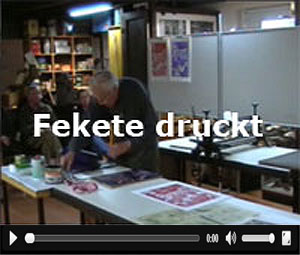 |
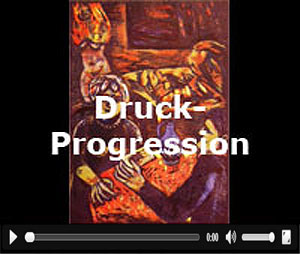 |
sorry, only in german language
![]() The Design of a Picture
The Design of a Picture
At the beginning Fekete chooses one of his oil paintings or mixed technique pictures as basis for the colored woodcut. At first he decides the format or the size of the picture which can be the same, larger or smaller than the painting. Since he is not using black outlines, Fekete must consider the colors and the number of color areas he needs for the picture composition. In fact, he is not interested to simplify the various picture elements but, on the contrary, he wants a fine and richly nuanced print that appears in as many color shades as possible.
The Wood Block
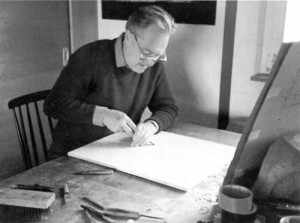
Working on wood block
The sequence of the wooden plates or so called wood blocks – usually four to six – is determined. Sometimes a block is used for two different paint applications.
Fekete preferred Gabonese or Ceiba plywood whose fine grain can be best utilized for his exceptional artistic objective. He usually prints on BFK handmade paper which has to be a heavy or light one depending on the size of the picture. The size of the picture and the wood block have to match exactly. The picture motives are taken from the original for each intended paint application and transferred to the wood block.
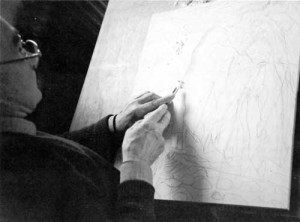
Scraped off the incised shape boundaries
The Tools
The most important outlines are achieved with the scalpel which can cut in an angle. All further surface area of the wood – those that are not to be touched by the paper- are scraped away with a flat or a spoon chisle. Only the elevated parts receive paint, therefore the term relief printing.
The paint
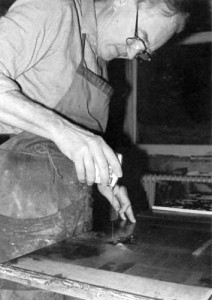
Dilution of the oil paints
There are hardly any white parts in a Fekete picture. Each color covers the whole plate. Color overlapping is planned from the beginning, resulting in the rich color shades. Only small segments shine in just one color. These wafer-thin color glazes printed on top of each other finally achieve transparency and clear depth.
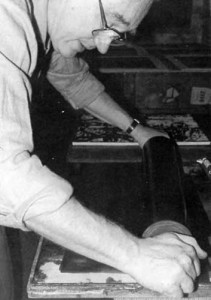
Application of paint to the wood block
Without exception, Fekete prints with the paints of his oil paintings. Each paint and a thinner are usually mixed on a glass plate with a spatula, then applied onto a hard rubber cylinder by rolling it back and forth and, finally, rolled with strong pressure onto the printing block.
The paper
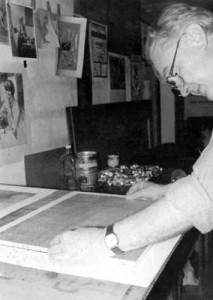
Precise placement of the printing plate to the paper
The wood plate, moist with color is lifted, turned around and carefully and perfectly fitted onto the paper. Then both together are lifted and put onto the bottom plate of a hand press. A felt blanket covers the paper. It ensures the utmost bonding with the laid paper and it also protects the wood plate. All layers are cranked through between metal cylinders.
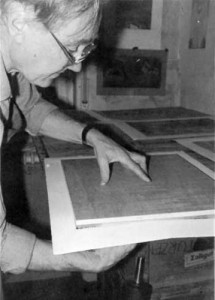
Preparing for printing
The picture composition is now mirrow-image, of course.
The motives are most precise and also darkest where most of the paint is on top of each other. The contours are gentle, very distinct but have no harsh outlines.
Printing Press
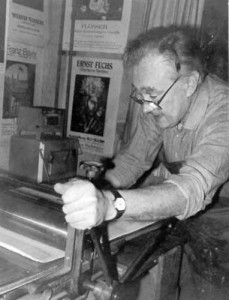
Printing process
The printing process is strength and time consuming. It sometimes also requires a change in the color sequence. Oil paints have various degrees of color saturation which are not very predictable; transparent colors have to stand up against opaque colors. It requires fun in experimenting and lots of experience.
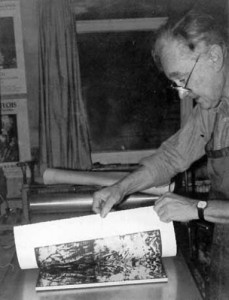
Separation of the paper from the printing plate
The printing process is an intimate work procedure which needs high concentration. Corrections are not possible contrary to painting. Thatʻs why Fekete never delegates and only prints himself.
A Fekete woodcut is always clearly recognizable. It shines polyphonic like a large chamber orchester and has the color magic of a painting. But it also appears more specific and structured, thanks to its natural wood imprint. The surface seems textural and it tempts one to touch it.
Fekete has put his „Form made of Color“ against the unwritten law „Form before Color“. His artistic objective and way of printing cannot be found in any text book. With it he has added a new facet to the traditional art of printing a woodcut with several plates.
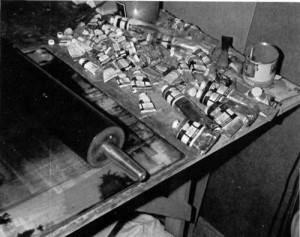
Oil paint tubes and rubber roller


 In the list of languages, click the Translationbar and choose the entry according to your language:
In the list of languages, click the Translationbar and choose the entry according to your language: